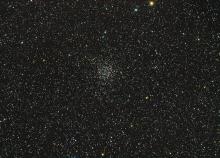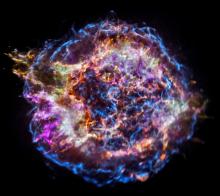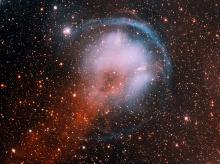Listen to today's episode of StarDate on the web the same day it airs in high-quality streaming audio without any extra ads or announcements. Choose a $8 one-month pass, or listen every day for a year for just $30.
You are here
Schedar
For a star that doesn’t have any close companions, its future is determined at its birth: Heavy stars live much shorter lives than lightweight stars. In fact, if you give astronomers a star’s mass, they can tell you just how long the star will spend in the prime of life — a phase known as the main sequence.
The leading light of the constellation Cassiopeia has already completed that phase. Now, it’s in the next phase of life — as a red giant.
Schedar is between 100 million and 200 million years old. By comparison, the Sun is four and a half billion years old. And it’ll spend billions of years more on the main sequence before it becomes a giant.
The difference is mass. Schedar was born about five times as massive as the Sun. At that great heft, gravity squeezed the star’s core much more strongly than the Sun’s core. That made the core extremely hot, which revved up its nuclear reactions. As a result, Schedar “burned” through its original hydrogen fuel in a hurry.
When the hydrogen was gone, the star’s outer layers puffed up, making Schedar much bigger. That also caused the surface to cool off. So while the star spent its time on the main sequence shining blue-white, now it’s reddish orange — a big change for a big star.
Cassiopeia is about a third of the way up the northeastern sky as night falls. Its stars form a prominent letter “W.” Schedar is at the bottom right point of the W — a young star that’s already nearing its end.
Script by Damond Benningfield






